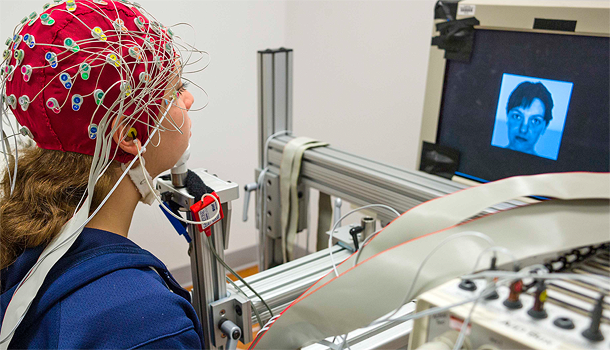
Making a game out of improving the 'sticky' brain
Monday 29 October 2012
UCSF neuroscientists have found that by training on attention tests, people young and old can improve brain performance and multitasking skills.
Anyone who tries to perform two tasks at once is likely to do worse on both. Why that is so at the neurological level has largely been terra incognita. But research now is starting to reveal the impact of multitasking on short-term memory and attention.
Adam Gazzaley and researchers at the UCSF Neuroscience Imaging Center use EEG, MRI and other non-invasive tools to study cognitive processes while people try their best on drills that test short-term memory.
In one early study, images of either faces or natural scenes pop up on a computer screen in random order, each for about a second. Participants are instructed to focus on one type of image — their target image — and ignore the other type. Soon afterward, they are shown either a face or a scene and asked to press a button if this is their target image.
The task challenges participants’ visual attention and memory in the face of distractions and multitasking. The “wrong” image is essentially a visual distraction from the task at hand.
The studies have revealed specific brain processing abilities that decline with age and compromise short-term, or “working” memory — a capacity that underlies performance on a range of cognitive abilities.
About one-third of seniors do as well as the average 20-year-old, Gazzaley found. But most perform considerably less well. Many researchers have hypothesized what brain functions account for the differences. Gazzaley’s lab has sorted through the possible explanations using the brain imaging measurements.
Changes in blood flow to different brain regions show that, compared to younger people, the visual perception parts of the brain in most older people get stuck on the wrong images. This, Gazzaley said, overburdens short-term memory and explains poorer performance.
“Older people tend to ‘overprocess’ distracting stimuli, and they are also slower to recover their focus after an interruption when multitasking,” he said. “There seems to be a stickiness in their brain’s ability to switch back to the main task.”
He calls this a deficit in “top-down modulation” — the ability of the conscious part of the brain to direct the visual part to return to duty. It’s the stickiness that interferes with short-term memory.
Gazzaley’s UCSF lab and others have found that by training on attention tests, people young and old can improve their brain performance and multitasking skills. His research shows that the benefits may spread to other crucial brain functions such as sustained attention.
Commercial “brain training” games have been on the market for more than a decade. Most rely on evidence that the drills work, at least for short-term improvement in working memory. But they don’t draw on the kinds of brain studies carried out in the UCSF lab. Recently, Gazzaley applied his brain physiology studies to the real world of video games. He worked with professional video game developers at a start-up company called Akili Interactive Labs to create an engaging game that draws on his lab’s research.
Gazzaley developed the predecessor to the soon-to-be-released commercial game, “Neuroracer.” In his prototype, players have to detect a target sign while driving a virtual car in a 3-D environment. The game can be used both for diagnosis and training. On the diagnostic side, preliminary results suggest that multitasking skills don’t just crash at a certain age, but may actually decline at a steady rate starting early in adulthood. The training results also show that older adults can dramatically improve their ability to multitask.
In 2011, Gazzaley filed a patent with UCSF that covers the use of the games for both diagnosis and training brain performance in the domains of distraction and multitasking.
Gazzaley’s findings have caught the attention of colleagues who work with autistic and seriously depressed patients. Some clinicians think that engaging patients in these games can improve their ability to concentrate.
“We’ve gone from lab-based studies of how the brain changes with age to demonstrations of novel approaches that can improve information processing and performance in older adults,” said Gazzaley. “If the new video games we are developing are engaging and fun enough for people to play often, then healthy adults may show significant benefits and so might individuals with cognitive disorders. That would be a very powerful outcome.”
See video with Adam Gazzaley: Is there a fix for memory impaired distraction?